
Staging the Bomb
by ELLISE BARKLEY, NIC MOLLISON, PAUL BROWN, LUKE HARRALD and TERESA CREA
- View Ellise Barkley's Biography
Ellise Barkley is a management and evaluation practitioner specialising in program design, impact, and partnership brokerage in community development, creative arts, education and sustainability.
- View Nic Mollison's Biography
Nic Mollison is a stage lighting and projection designer working across theatre, dance and youth arts companies on local, national and international productions, including lighting and video projections for concerts, festivals, nightclubs and visual art installations.
- View Paul Brown's Biography
Paul Brown is Producer for Alphaville, a Sydney-based arts company specializing in creative projects that have environmental, scientific and social themes; and he holds an honorary position in Environment and Society at University of New South Wales.
- View Luke Harrald's Biography
Luke Harrald is a composer, performer and new-media artist and Head of the Popular Music and Creative Technologies program at the University of Adelaide, and lectures in Sonic Arts.
- View Teresa Crea's Biography
Teresa Crea is an interdisciplinary artist and academic with credits as a writer, director and creative producer across a variety of media.
Staging the Bomb
Ellise Barkley, Nic Mollison, Paul Brown, Luke Harrald and Teresa Crea
Introduction
As introduced in earlier papers within the Unlikely collection, the Nuclear Futures Partnership Initiative was established as a three year community arts program to link teams of creative artists with communities that have experienced atomic testing and weapons use (See www.nuclearfutures.org). The program aimed to progress community development for these communities, and develop a new suite of story-based creative works (across multiple art forms) as a response to Australia's obscured nuclear history.1
One of the prevalent challenges facing the creative team was how to 'stage the bomb'-- how to creatively represent atomic testing and detonation (sans glorification) and authentically embed community voices via progressive storytelling and engagement techniques such as immersion. This dilemma attended the Nuclear Futures program as a whole (see also Murray, 'Where do you put the Bomb', this volume). It drove our choices of art forms suitable for community partners and for delivering the program's atomic storytelling objectives; and it provoked experimentation with creative techniques to construct original and impactful experiences, which would hold meaning for participating communities and engage audiences with little or no experience with Australia's nuclear test history.
This essay examines the creative processes, experimentation, technical approaches, and audience experience of our immersive installations developed across a two-year period, 2014-15, via a program of creative residencies with community and visiting artists. Here we give focus to the first piece produced, 10 Minutes to Midnight, made with the community of Australian nuclear veterans and first presented in the rural South Australian town of Balaklava, home of nuclear veteran Avon Hudson, a key Australian campaigner for veterans' rights. In 2015, a companion installation Ngurini (Searching) was developed with the Yalata Aboriginal community in the far west of South Australia. Jessie Boylan details this piece in 'Residual: after the event of Maralinga' (this volume).2 Together, the two installations cover the emergent community stories of the British led nuclear experiments in Australia, shared by service and civilian personnel.
10 Minutes to Midnight premiered as part of the 2015 Adelaide Fringe Festival, and fortified the involvement of regional towns in festival outreach. Since Balaklava, 10 Minutes to Midnight has been further developed and screened to community, school, and general public audiences at metropolitan venues including: The Block, Queensland University of Technology; The Pinnacles Gallery, Townsville (2D screening only); and Tandanya National Aboriginal and Cultural Institute, Adelaide.
The first part of the essay provides our description, reflection, and analysis of the social context, creative decision-making, and technical challenges of developing the installation, drawing on the multi-arts perspectives underpinning our approach to creating the immersive audience experience and staging the bomb. Included are accounts of the projection structure design, dramaturgy, and the visual and sound elements used in the moving image piece. As well as weaving together the multi-discipline insights arising from the creative challenge of 'staging the bomb', distinct practitioner voices from the creative team are embedded throughout the paper to highlight the nuanced multi-arts approaches applied to the shared design problem. In the latter section, we look at the summative findings from the project's evaluation, based on audience and community partner responses to the installation and art-making, and discuss the impact and implications of the creative work for communicating the nuclear age to audiences, and for extending community arts practice.
10 Minutes to Midnight in Development
Early Decisions
The first stage of creative development was held over a three-day creative residency at Balaklava in late 2014. The core creative team brainstormed ideas for a multi-disciplinary performance installation responding to the British nuclear tests at Maralinga. Together, the team brought expertise in dramaturgy, visual arts and photomedia, digital media, sound design, theatre, lighting, projection, and film-making.3 We initially had in mind a centrepiece performative work, to be presented alongside a biographical photographic exhibition about Avon Hudson' life work with the veterans of the Maralinga nuclear program. This photographic project was already in development as another wing of the Balaklava residency (see Boylan 'Whistleblower', this volume).
One of our team members, Director Teresa Crea, brought extensive experience of community-based arts, and in 2014 she was seeking to extend such work to include digital projection and immersive environments, while tackling the difficult and contested perspectives inherent in the material dealing with the Maralinga bomb tests. The key decision was how to frame the narrative.4
My interest in neuroscience had made me highly aware of the role of narrative framing in influencing how audiences and listeners receive and interpret events. We knew inherently, given the place and timing of the final presentation in Balaklava, in front of direct eye witnesses, and in the light of the re-emergence of the nuclear debate in South Australia, that we carried an enormous responsibility towards the audience and community participants. We grappled with how to tell the story in a way that did not betray any of the stakeholders and at the same time allowed audience members, each with distinct and individual views on nuclear issues, the freedom to make up their own minds about the Nuclear Atomic tests at Maralinga. (Crea, sourced from Alphaville documentation records)
At the conclusion of the first workshop, the decision to employ moving image and present the work within a custom-designed 360˚ surround projection structure emerged as an experimental, creative proposition.
From this first residency, our aim became to situate the audience at the tests, with the bomb staged using immersive techniques and a sequenced simulation of the preparation, experimentation, countdown, detonation, and blast. We wanted to totally immerse the audience, encapsulating their entire field of view, giving them a sense of a vast landscape at Maralinga and placing them at ground zero. We proposed that embedded with the moving image should be an original register of voices including verbatim oral histories from eyewitness nuclear veterans, personal testimonies from family members and descendants of nuclear veterans, and historical scientific and political motivations. We also hoped the work would reveal the creative team's own response to the human and environmental legacies of the bomb, while reflecting community sensibilities. Crea reflects:
The ability to be with the community, to hear voices and perspectives as varied as local community councillors to eye witnesses, to read newspaper reports of the time and engage in long conversations with Avon Hudson over cups of tea, built a mosaic of impressions and understandings that sank deep into our psyche. This was something shared by all the collaborators. "Staging the Bomb" was not just an artistic problem. We had all had direct, tangible contact with the ramifications of the bomb tests on the lives of a community -- and responses by necessity reverberated with that knowledge. (Crea, sourced from Alphaville documentation records)
The title of the work, 10 Minutes to Midnight, emerged in reference to the Doomsday Clock, a symbolic clock face set periodically by the Bulletin of Atomic Scientists -- whose contributors continually alert us to the dangers of the nuclear age. The lowest the clock has been (i.e. most optimistic) is '17 Minutes to Midnight', in 1991 as the prospect of nuclear disarmament seemed strongest after the fall of the Soviet Union. It has been as high as 2 minutes to midnight, as it was across the period when Maralinga bomb tests were carried out. The clock was set at '10 Minutes to Midnight' in 1969 when almost all nations signed onto the Treaty on the Non-Proliferation of Nuclear Weapons. However, in recent years, the Doomsday clock been set first at 3 minutes to midnight, and in 2017 at the time of writing at two and a half minutes to midnight, in recognition of threats from climate change and ongoing nuclear weapons development.5 Creative Producer Paul Brown explains:
Our title conveys the essential optimism that we can begin to wind back that clock. '10 Minutes to Midnight' also relates to the playing out of Avon Hudson's own life as a campaigner, and it relates to one of his obsessions -- clocks. We felt that our circular projection area would provide some semblance of a clock, therefore placing everyone within its workings. (Brown, sourced from Alphaville documentation records)
Technical Matters: Proof of Concept
Adelaide based theatre designer and lighting technician Nic Mollison joined the Balaklava creative team in 2014, initially briefed that the project would be a theatre production. But he also brought experience and interest in computerised projections:
Once we decided on the 360˚ projection performance space, it was my role to create a proof of concept and to build a prototype in Adelaide by mid January 2015. I had to determine the optimum size and scale of the space, taking into consideration the minimum audience capacity required, various technical limitations including projection distortion issues and the budget. I was also aware that the structure would most probably need to be portable for touring. After numerous iterations of scale models and computer visualisations, it was determined that the sweet spot for the structure design was 8 metres wide and 3.2 metres tall, with a small opening for the audience to enter the space. This would allow for an audience capacity of approximately 24-28 people, each with enough space to see and experience the work comfortably and unobscured. (Mollison, sourced from Alphaville documentation records)
Other influencing factors were the need to limit the overall weight and twist distortion of the frame, the available space in the venue, manageability for future touring and having a large enough diameter so that the distortion of the projections would be manageable and successfully corrected using the available software.
The software solution chosen for the presentation of the video and audio score was QLab Version 3, which by chance had cylindrical distortion correction built in to the latest version only a couple of weeks earlier. This was extremely useful, both technically and economically, as up to this point we would have had to have used multiple software programs to achieve the same result. This would have also raised the cost and overall complexity of the control system, requiring substantially more technical support and development time to implement. QLab V3 enabled us to output vision to the 6 projector outputs, perform the edge blending and projection mapping, video and audio sequencing and trigger all the lighting cues programmed on a separate Laptop running GrandMA on PC software via a Midi Network. (Mollison, sourced from Alphaville documentation records)
After extensive testing, pre-visualisation and modelling (See Figures 1,2,3, and 4 below) we felt we had a proof of concept that enabled us to move forward to the construction phase. We fabricated the main circular structure using 20mm square 3mm wall tubular steel in 8 sections that would bolt together for portability. There were four pickup points to hang the ring at the desired height (3.2 metres). The ring height could be adjusted as required to get it dead level. The final design of the frame was two concentric rings connected with 200 mm vertical struts, and this design solution worked well to minimise any undesirable twist distortion around the 25 metre circumference.
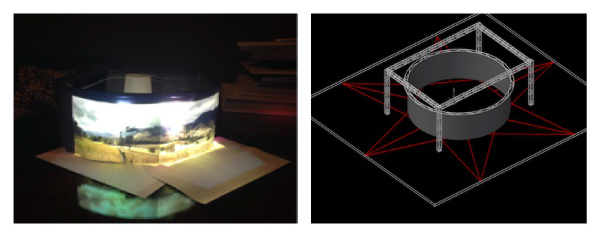
Figure 1 (Left). 1:100 Scale model with Rosco rear projection material and 2 projectors to determine level of distortion and image blending required.
Figure 2 (Right). Early CAD Visualisation showing 6 x data projector position, 360˚ projection space and self supporting truss structure position. Images Nic Mollison.
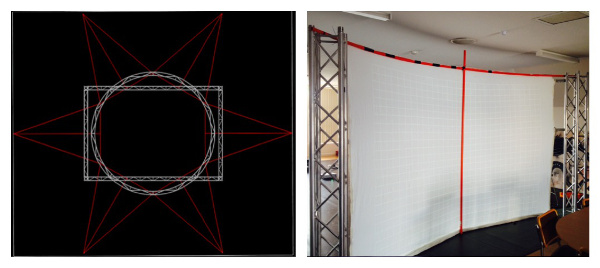
Figure 3 (Left). Early CAD Plan (Top) View showing Data 6 x projector position and self supporting truss structure position.
Figure 4 (Right) The 1:1 Scale section mock up to test the extent of the curvature of the projected image. Images Nic Mollison.
Prototype
We installed the prototype at the Maritime Workers Hall, the Vitalstatistix Theatre Company headquarters in Port Adelaide. This three-week development period was also dedicated to the creation of the video and audio content as well as lighting design testing.
We first installed the prototype circular projection frame, (See Figures 5&6 below) and attached temporary projection material; and we ordered seamless rear projection material from a US supplier.
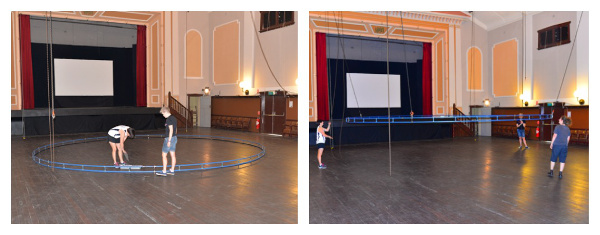
Figure 5 (Left). Installing the top ring frame at the Waterside Workers Building Port Adelaide Jan 2015.
Figure 6 (Right). Installing the top ring frame at the Waterside Workers Building Port Adelaide Jan 2015. Photos Nic Mollison.
After some nerve wracking Australian Customs delays, the specialised rear projection material arrived safely to replace the prototype screen. This material is manufactured specifically for rear projection purposes and enhances the brightness of the projected image while limiting unwanted effects of spill and ambient light on the projected surface. This material provided a completely seamless projection surface of 25.13 metres in length by 3.2 metres tall, and was a cost-effective solution. Once the projection material was attached the top ring frame, we inserted PVC Electrical conduit to create a bottom ring that was then secured to the floor. We found this solution to be too flexible and difficult to secure to the floor uniformly. The fabric under tension created unwanted hour glass distortion which complicated the projection mapping process substantially. (See figures 7&8 below)
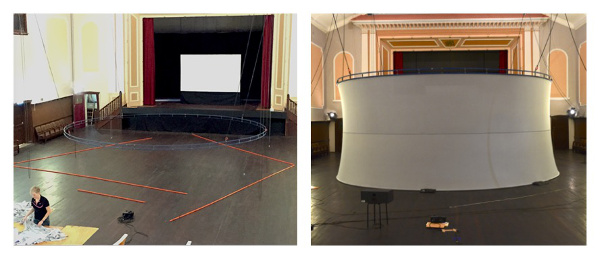
Figure 7 (Left). Preparation to construct prototype Bottom Ring made from electrical conduit PVC piping.
Figure 8 (Right). Temporary Prototype Fabric showing unwanted hourglass distortion creating the Nuclear Cooling Tower. Photos Nic Mollison.
Refinements
To limit the undesirable movement and distortion of the projection surface, we needed a rigid steel ring and door frame battens to tension and smooth out the projection surface. This provided a more uniform tubular shape and limited the unwanted hour-glass distortion when the material was under tension. This finessing was crucial to minimise time required for projection mapping in situ.
In our design for Balaklava, the six data projectors were positioned on the floor outside of the projection space. We found this created numerous challenges with the projection mapping process. The floor in the venue was extremely uneven, making it too difficult and time consuming to blend the image between the six projectors. After the Balaklava season, for all following productions we rigged the projectors from inside and above the centre of projection space, to alleviate these projection mapping problems. This central overhead mount reduced the overall footprint of the installation considerably, allowing its use in smaller venues.
Due to extra due diligence and attention to detail in planning and construction of the prototype, the structure exceeded everyone's expectations in regards to how well it presented the mapped and blended projected imagery. The prototype emerged as the final iteration of the design that would need only a few refinements to successfully tour to multiple locations around Australia. (Mollison 2016)
Creating Audience Experience: First season at Balaklava
It was in the rural hometown of nuclear veteran, campaigner, and whistleblower Avon Hudson in the Mid North Region of South Australia, that we undertook community arts and cultural development activities and presented a community showcase. At the centre of the showcase was the 10 Minutes to Midnight installation, attended by over 400 local residents and visitors over the four-day season, programmed within the 2015 Adelaide Fringe Festival.
Programming for the Adelaide Fringe Festival has evolved and become more inclusive each year, and in this spirit the festival encourages the involvement of regional South Australian towns. With local agreement, Balaklava Town Hall registered as a festival venue, thereby ensuring promotion of our installation as a Fringe show. The first presentation of 10 Minutes to Midnight, at the Town Hall, took place on 13 February 2015. As broader context, as our 2015 Fringe production opened, the South Australian Premier announced the Royal Commission into the nuclear fuel cycle in preparation for a proposal for a Nuclear waste repository in South Australia. Nuclear issues were at the forefront of people's consciousness and present within the media. (See Brown, 'Rebellious Art', this volume.)
The event comprised the screening itself, followed by an interactive seminar in which creative processes and nuclear issues were discussed.6 In parallel, the Balaklava Courthouse Gallery presented our photographic exhibition Portrait of a Whistleblower, with audiences strolling the three blocks to switch between the two venues. (See also Boylan: 'Whistleblower', this volume.) The directorial and artist program note for the Balaklava season of 10 Minutes to Midnight read:
10 Minutes to Midnight sits at the creative junction between history, eye-witness testimony and artistic interpretation. [It] is our response as a team of artists to the testimonies we have heard and the archival information we have uncovered about the British Atomic Bomb experiments conducted in South Australia during the 1950s and 60s. While it draws on eye-witness accounts and factual archival material, the installation offers an impressionistic reflection on the experience of the bomb tests from the perspective of many who were directly implicated, leaving us as artists and audience to ponder the consequences of those actions... As artists, we would like to acknowledge that this story has very profound consequences for the local indigenous communities, the Anangu traditional owners and that there are atomic survivor cities in many parts of the world. The stories in our presentation provide but one chapter in a pressing global narrative.
At Balaklava, the audience experience of 10 Minutes to Midnight began as a journey -- at first ushered from the small foyer as a group by the front of house staff guiding them in the darkness. Then as they turned the corner into the main Hall, the audience encountered an illuminated pathway that guided their way into the projection cylinder. Once inside the cylinder, they were greeted by 'Mrs Titterton' a gas-masked mannequin used as a focal point in the centre of the installation, creating an additional presence and adding counterpoint to the projected imagery. (See figures 9&10). We purposely left the meaning of this macabre figure open to interpretation, though we ourselves understood her to represent the British scientific establishment. 7 The piece ran for 24 minutes. Nic Mollison reflected on the process of developing and presenting the screening:
During the content creation phase my own experience as the viewer within the space had been quite overwhelming at times, especially when all the sensory elements of light, sound and moving image were synchronised well together. We were able to gauge this intensity and use it to our advantage when desired and then suppress it to achieve quieter more subtle moments that the audience could reflect on. These quieter more reflective moments were achieved using pre-recorded voice and written text of eyewitness accounts of the Maralinga Nuclear test program and its subsequent effect on their lives. (Mollison, sourced from Alphaville documentation records)
The piece juxtaposes these accounts or testimonies with imagery of the vast Maralinga landscape or within an imagined nuclear veterans memorial, and this gives the audience an opportunity to observe more reflective, calmer moments within the work. Poignant video of Pitjantjatjara country filmed by photomedia artist Jessie Boylan were integrated with original digital artwork by Linda Dement depicting the invisible and insidious spread of radiation and disease. Statistics and government quotes were included, as were oral history excerpts and archival footage of the British led nuclear tests in Australia during the 1950s and 60s (courtesy of the UK Imperial War Museum). (See figures 9-13)
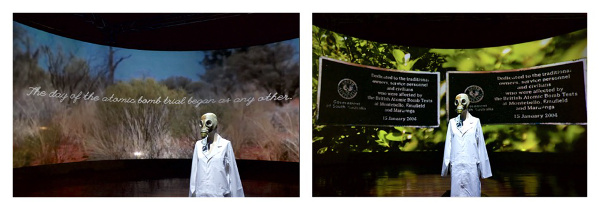
Figure 9 (Left). Maralinga Landscape (Jessie Boylan) with eyewitness testimony.
Figure 10 (Right). The Imagined Nuclear Veterans Memorial. Photos Nic Mollison.

Figure 11 (Left). Digital artwork (Linda Dement). Photo by Paul Brown.
Figure 12 (Centre). 'Babies' Bones' digital artwork (Linda Dement) (See Dement's essay 'Invisible Memorial' in this volume). Photo by Paul Brown.
Figure 13 (Right). 'Strontium 90 formula, digital artwork (Linda Dement)). Photo by Tania Safi.
Regular recurring motifs of a ticking clock, Instruction titles, spoken countdown and gong sounds were used to build the tension throughout the 24-minute work. The sound design was undertaken by Luke Harrald, and included original composition. Harrald reflects:
Something that is perhaps not obvious in our visually dominated world is that sound often impacts on how we feel more than vision. This is well understood in cinema, and is particularly well developed in suspense and horror films, where the sense of tension and suspense is primarily driven through the sound track (Augoyard and Torgue 2005). Equally, sound also impacts our everyday experiences and affects how we feel about, and relate to particular places. (Harrald, sourced from Alphaville documentation records)
In constructing the soundtrack, a series of aural scenes were created whereby the variety of materials were broken down into individual sound symbols that were subsequently repeated, layered and elaborated on -- to build up the immersive audience experience of the work, and create layers of meaning. At times, the aural scenes work closely with the visuals, at others they pre-empt events later in the installation or refer to earlier sections. This approach draws on the work of UK composer Trevor Wishart (Wishart and Emmerson 1996), and the concept of creative metaphor, pioneered by cognitive linguist George Lakoff (Lakoff and Johnsen 2003). The power of sound to invoke memories through anamnesis is well documented, and the repetition of sound symbols is used throughout the work to constantly shift the audience's sense of perspective, not only building their understanding within the narrative of the work itself, but also connecting with each audience member's own memories and experiences. This enables a deep sense of engagement with the work, and the wide variety of contemporary and historical materials that are presented.
When it came to placing 'the bomb' in the installation, from the perspective of sound it was rather curious as there is only one known declassified sound recording of a nuclear test: Annie, from Operation Upshot-Knothole at the Nevada test site in the USA. All other film footage is overdubbed with recordings of TNT to give the explosion an impressive sound that the viewer -- particularly military personnel, familiar with conventional weapons -- might expect. Initial experiments involved restoring and incorporating audio from the Annie test into the installation, but this did not achieve the level of impact required for the work as the authentic recording sounded more like a giant gunshot followed by an earthquake as opposed to a typical explosion. Much like in the bulk of test footage, the audio here was also based on recordings of TNT, but made use of the timing of the test footage for greater authenticity, to give the audience a sense of witnessing a test. (Harrald, sourced from Alphaville documentation records)
Overall 10 Minutes to Midnight breaks down into 7 distinct sections, and these sections vary in pace and intensity. The recurring audio and visual motifs are repeated at the beginning of each section creating a sense of urgency that gradually builds. The final sequence is more frenetic, using previously presented archival footage layered as pastiche. Robotic lighting fixtures are used to scan across the audience creating an extra layer of movement within the space. All of these elements when combined with the dynamic surround sound score consume the audience right up to the final moment of the atomic blast, where all visual and aural elements climax to a single moment for maximum impact (See Figures 14-17). A jumpscare technique was employed for staging the bomb, supported by the suspense created during the final sequence, where a silent extended visual of the detonation is shown, ahead of the thunderous roll of the blast -- abrupt and to some degree frightening.
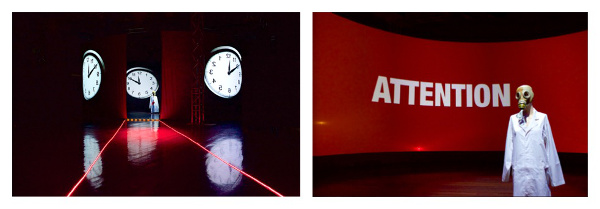
Figure 14 (Left). The Illuminated Pathway that guided audiences into the space and the recurring ticking clock motif. Figure 15 (Right). Instructional titles for the audience to follow as they witness the nuclear bomb test, with Mrs Titterton observing and collecting important scientific data. Photos Nic Mollison.
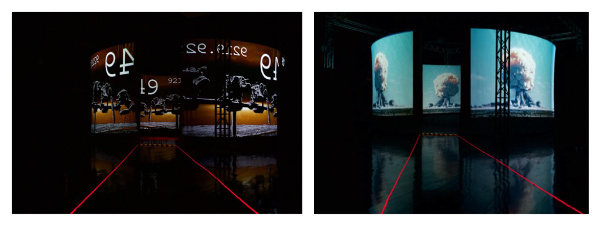
Figure 16 (Left). Final VJ Sequence observed from outside the installation.
Figure 17 (Right). Final Sequence observed from outside the installation. Photos Nic Mollison.
Impact and audience response
Evaluative processes
Across the Balaklava season, and then across later showcase presentations, the core creative team constantly evaluated and considered the audience point of view within the space in order to further develop the work. We regularly discussed and questioned the audience experience of our 'staging of the bomb'. Questions that were asked included: What information do we want the audience to focus on? How does it make you feel -- comfortable? uncomfortable? What is the desired emotional or physical response? Is the audio too loud? Is it too visually intense? stressful or calming? Our ultimate goal was to take the audience on a sensory journey by presenting factual information, eyewitness testimony, archival footage creating a visual art installation that could evoke multiple emotive states. We placed the audience within the experiment, they were willing participants but understandably apprehensive about what they may learn about our hidden nuclear history. Mollison, projection designer, reflects:
Our understanding of the 360˚ projection space evolved from a desire to totally immerse the audience and capture their entire visual and auditory fields. This sensory space was designed to limit any outside distractions. We could then control everything the audience would see and hear within that environment. The considered use of the 360˚ surround sound and visuals together with tightly sequenced and programmed lighting effects was used to try and connect more deeply and more quickly with the audience when presenting them with the story of South Australia's Nuclear past. When all these sensory elements are presented together with the evocative, relevant and truthful human stories, it was difficult not to feel wide range of emotions from intrigue, disbelief, empathy, horror, fear, sorrow and awe while being totally enthralled and mesmerised whether knowingly or subconsciously as the story unfolded. (Mollison, sourced from Alphaville documentation records)
Throughout the art-making and public screenings, we also undertook rigorous data collection and analysis for evaluation purposes, to gauge the outcomes and impact of the community arts practice and the emergent artwork of the Nuclear Futures program. We used the READ model, an approach integrating Reflection, Evaluation, Analysis and Documentation (Barkley, 2016a; and the essay 'Making the Story Go Far' by Barkley, this volume). The evaluation of the projection installation was based on the analysis of data captured from qualitative (including rich media) and quantitative sources throughout the program's duration including: written and video reflections by the creative team and community partners; feedback forms and surveys completed by participants and general/secondary school audiences during the season; vox pop video interviews; and post event documentation. This was part of a broader Nuclear Futures process of evaluation, reporting, and research, that produced findings specific to the 10 Minutes to Midnight installation in the domains of community art-making and artist merit; audience engagement; staging the bomb.8
Measuring impact
In early interviews with nuclear veteran Avon Hudson, when asked what would constitute project success, he identified his want for the stories to go far -- for mainstream audiences to be engaged; for public awareness about Australia's atomic test history to be increased; and that public recognition for impacted communities be promoted. Evaluation research conducted via Queensland University of Technology and Nuclear Futures' summative evaluation confirmed that these, and other partner objectives, were unequivocally achieved (See Alphaville 2017 and Barkley 2016).
Of particular importance was community sentiment from the nuclear veterans and families involved and attending 10 Minute to Midnight screenings which consistently affirmed the success of the artwork in conveying the atomic survivor stories, as demonstrated by remarks such as: "It was more than I could have hoped for" (nuclear veteran). Creative team digital artist Linda Dement reflects:
I was thrilled and relieved when Avon saw the work and afterwards said "Well you got that right." I had been holding my breath up until then, a little concerned that we may not have told the story in a way that aligned with his experience. (Source: Alphaville evaluation records)
Evaluation findings also revealed the impact of the community arts practice had on the team. Videographer Tania Safi for Balaklava's documentation stating:
Avon and the Nuclear Futures team reminded me of the importance of speaking out, standing up, and the importance of creating art that captures the story of people who are brave enough to do that. (Source: Alphaville evaluation records)
As a community arts project, the development of the installation achieved the goal of marrying art (high end art) and genuine community engagement, and the evaluation results from audience reviews of the 10 Minutes to Midnight artwork attributed high levels of artistic merit to it.9 It was also found that for the majority of secondary students attending the installation (and accompanying showcase), this was the first time they had learnt about South Australia's atomic test history and they noted that there was little or no previous knowledge about the Cold War context in their curriculum. 10 The capacity of the installation to innovatively deliver information via the artform was considered by audiences as one of the strengths of the work, and many young people in particular praised the artwork as "a different way to learn". Production manager and lead evaluator Ellise Barkley recalls:
We were surprised by the level of detail of information that audiences were able to retain from a single viewing of the work. The recurring motifs and repetitive nature of the content enabled audiences to willingly engage with the work even though the subject matter was quite confronting and challenging. It was clear from the written feedback especially from the young members of the audience that they were totally unaware of Nuclear program conducted in South Australia. Many could not understand how or why this could have happen and were keen to learn more about South Australia nuclear History. A number of the written comments highlighted the effective integration and contribution of the lighting, sound and projections to their overall experience of the show. (Barkley, sourced from Alphaville documentation records)

Figure 18 (Left). Inside the installation.
Figure 19 (Right). Students inside the installation. Photos by Tania Safi.
Portraying the nuclear age and the stories of affected atomic survivor communities via an immersive experience was affirmed as highly effective by audiences, as it created "raw intensity", "realism", and a space where "you can really live yourself in the story" (See figures 18 and 19). Comments about the immersive effect included:
- "How interesting the installation was and how immersive the presentation was..."
- "How immersive it was. The sound. The mannequin and having to look around a lot gave an immersive experience"
- "The film was astonishingly powerful. Not only was it visually powerful, but the use of a 360-degree projector and mannequin allowed for full impact, one which amazed everyone inside. Absolutely inspiring... [the question I am left with is...] How do I impact people in that way?"
More broadly across the feedback, the installation was described as moving and impactful, with indicators that the experience of viewing the artwork changed audience perceptions and awareness levels about Australia's atomic history, and/or catalysed further questioning or re-evaluation of Australia's nuclear history. The evaluation also generated information about the effectiveness of specific creative devices and techniques employed, and this informed our further development of the work, and the production of its companion piece, Ngurini (Searching). When asked what young people most liked most about the installation, 75% of respondents identified elements that contributed to the immersion (citing visual, sound and lighting effects), with 43% of these comments related to the staging of the bomb, including the jumpscare, quoted as their favourite part of 10 Minutes of Midnight. This was consistent with general audience feedback which indicated that the count down and moment of the blast was an outstanding, impactful, and memorable element of the piece.
Conclusions: community storytelling for the nuclear age
The concept of the 360˚ projection space is not new, and many institutions have installed similar projection environments to facilitate research and innovation in the fields of virtual, augmented reality and simulation. The University of New South Wales iCinema is just one example. Such environments are also constructed as permanent installations in museums and used commercially in the Advertising, Mining and the Themed Entertainment industries, usually at great expense and vast technological resources.
What positions our work differently is the overall portability of the structure and accompanying technology which enables the space to travel and be installed quickly in regional and remote communities. This democratisation of the work gives regional audiences the opportunity to experience an immersive multidisciplinary installation that tells the story of our nuclear past and continuing legacy in an innovative presentation environment well outside of the more traditional gallery or theatre setting. Our experience in Balaklava revealed that the rich application of multi-media material and innovative use of technology for the installation challenged the type of art traditionally created and presented in the region, which generated great interest across the multiple generations of participants and audiences.
While the installation was achieved at a small fraction of the cost of comparable more permanent installations currently in use, the scope and scale of the installation project represented a significant undertaking and achievement within the community arts context.11 The application of the immersive audio-visual technologies enhanced the reach and outcomes of our community-based arts practice, and transformed our capacity to communicate the nuclear age to audiences, many of whom were previously unaware of Australia's devastating nuclear legacies.
Audience response evidenced that the primary impact of the 10 Minutes to Midnight installation was created through immersion in the story content, and this was the combined effect of the moving imagery film, the sensory space created by the surround projection arena, and the nuanced lighting, sound, and timing and arrangement of theatrical devices employed to engage, evoke, challenge and connect to the audience. (See also Crea, 'Neuroscientific perspectives on the atomic art of Nuclear Futures', this volume).) The feedback also evidenced that the immersive approach deepened the experience of the atomic-related artwork and bridged the stories more personally to the viewer. The creative team built suspense, intensity and emotion, leading throughout the piece towards the pending blast of an atomic bomb, as the closing scene of the installation. The impact achieved via this experience was verified through the high frequency of audience references to the applied design elements delivering the immersive effect, and the moment of the simulated blast ('the bomb') itself which was described as captivating and powerful for many viewers.
In addition to the visual and audio effects of the moving image film, the experience of sitting inside the circular screen itself, with the varied projection light illuminating the audience created intimacy and a shared experience with other audience members, and the evaluation verified that this had a powerful effect. In the feedback, several audience members remarked that witnessing others' experience and reactions during the screening added to the emotion and experience. We experienced this as the creative team on numerous occasions, when sitting with community members viewing the installation for the first time, as we were able to witness facial expressions, raw emotion, reaction, fear, surprise, awe, shock and tears while showing the work back to community.
Based on the findings it can be argued that 10 Minutes to Midnight projection installation makes a valuable contribution to the existing body of work that responds to, and sheds light on, Australia's atomic legacies given its innovative, immersive approach and demonstrated effectiveness of techniques. In experimenting with new approaches to the challenge of 'staging the bomb', the installation achieves a visceral, yet personal and factually grounded experience of the atomic test history, delivering vibrancy through the quality of the artwork and education outcomes, such as raising awareness, prompting further research, and dissemination of previously unseen information/ artefacts in the public domain.
The process of creating and presenting 10 Minutes to Midnight, and the accompanying showcase and public speakers forum, in a small regional community such as Balaklava made the community feel valued and listened to. The overwhelming sense from the community was that these are important stories that needed to be told and retold, they serve as a bleak reminder to everyone including Local, State and Federal Governments, private corporations and the general public of the horrific mistakes of the past that still need be acknowledged. It is hoped that through the creation and presentation of community arts projects like 10 Minutes to Midnight we can continue to shine a light on our hidden nuclear past and its continuing legacy, and keep these important issues in the forefront of the current nuclear debate.
Works Cited
Alphaville. 2017. Nuclear Futures Partnership Initiative 2014-6 Evaluation Report, unpublished document available from Alphaville (alphaville@iprimus.com.au).
Alphaville. 2018. Archival and program documentation records collected, 2013-17 accessible on request from the National Library of Australia.
Augoyard, Jean and Henry Torque. 2005. Sonic Experience, A Guide to Every Day Sounds Kingston: McGill-Queens University Press.
Australia Council for the Arts. 2012. Artistic Vibrancy Framework. Web.
Barkley, Ellise. 2016. An integrated approach to evaluation: A participatory model for reflection, evaluation, analysis and documentation (the 'READ' model) in community arts. Doctor of Creative Industries Thesis. Brisbane: Queensland University of Technology.
Barkley, Ellise. 2018. 'Making the Story go Far: Reflection, Evaluation, Analysis and Documentation'. Unlikely: Journal for Creative Arts.
Boylan, Jessie. 2018a. 'A Fight for Recognition: Making Portrait of a Whistleblower'. Unlikely: Journal for Creative Arts.
Boylan, Jessie. 2018b. 'Residual: Art Beyond the Event of Maralinga'. Unlikely: Journal for Creative Arts.
Crea, Teresa. 2018. 'Neuroscientific Considerations in the construction of Ten Minutes to Midnight'. Unlikely: Journal for Creative Arts.
Hammons, Steve. 2015. "Storytelling affects human biology, beliefs, behaviour". Culture Ready Blog Defence Language and National Security Education Office. March 23 2015. Web (Viewed January 20 2017).
Lakoff, George and Mark Johnsen. 2003. Metaphors We Live By. Chicago: The University of Chicago Press.
Wishart, Trevor and Simon Emmerson. 1996. On Sonic Art. Harwood Academic Publishers.
Footnotes
- The full scope and implications of the program are examined in detail by Brown ('Rebellious Art', this volume), by Barkley ('Making the Story Go Far', this volume) and by other authors in this collection. Another companion paper is by Teresa Crea: 'Neuroscientific perspectives on the atomic art of Nuclear Futures', this volume. ↩
- Ngurini (Searching) explores the legacy for affected Aboriginal communities and traditional lands, caused by nuclear contamination and the forced community migration of Anangu peoples from Maralinga Tjurutja Lands to Yalata. ↩
- The visiting creative team was led by South Australian Director and dramaturg Teresa Crea, overseen by Alphaville's Creative Producer Paul Brown, and included 10 other experienced artists from multi-arts disciplines. ↩
- "A listener's psychological reaction to narrated events is influenced by how the narrator frames the events, appealing to different values, knowledge, and experiences of the listener. Narrative framing that targets the sacred values of the listener, including core personal, nationalistic, and/or religious values, is particularly effective at influencing the listener's interpretation of narrated events. These values are closely tied with the psychology of identity, emotion, moral decision making, and social cognition" (Hammons 2015) ↩
- The Doomsday Clock, Bulletin of the Atomic Scientists: a committee of eminent scholars opposed to nuclear weapons. Website. ↩
- The coordination of the Balaklava showcase and partnership development was undertaken by Production Manager Ellise Barkley, Creative Producer Paul Brown, and local coordinator Carly Friedrichs. Production and documentation was supported by projection specialist Rowan Lee and videographer Tania Safi. ↩
- Ernest Titterton was a key scientist involved in the Maralinga tests. ↩
- For the artistic evaluation elements of the Balaklava project review the Artistic Vibrancy Framework, developed by the Australia Council for the Arts (2012 CHECK), was also as a source of criteria. ↩
- Consistent with Australia Council for the Arts' classification for 'great' art as defined in its Artistic Vibrancy framework: "demonstrates integrity of process; embodies excellence of craft and skills; demonstrates imagination, distinctiveness and originality; contributes to artistic practice; engages with the diversity and complexity of contemporary life; and is relevant in a local, national and global context" (See e-book introduction). ↩
- Student evaluation was based on 270 collected feedback forms, and a small sample of vox pop and interviews, across three seasons of screening (Balaklava, Adelaide and Brisbane) in 2015-6. See Barkley (2016a). ↩
- On reflection, feedback from artists and project partners acknowledged that the enormity and quality of the final creative work achieved was impressive (given the budget and timeframe) and achieved outcomes beyond expectations. ↩

